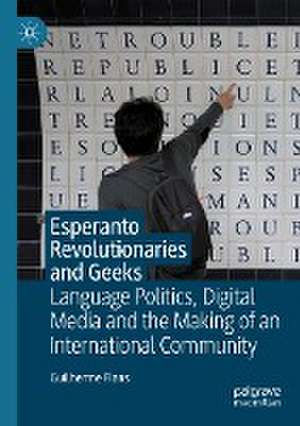Esperanto Revolutionaries and Geeks: Language Politics, Digital Media and the Making of an International Community
Autor Guilherme Fiansen Limba Engleză Paperback – 6 ian 2023
| Toate formatele și edițiile | Preț | Express |
|---|---|---|
| Paperback (1) | 724.32 lei 6-8 săpt. | |
| Springer International Publishing – 6 ian 2023 | 724.32 lei 6-8 săpt. | |
| Hardback (1) | 729.53 lei 6-8 săpt. | |
| Springer International Publishing – 5 ian 2022 | 729.53 lei 6-8 săpt. |
Preț: 724.32 lei
Preț vechi: 883.31 lei
-18% Nou
Puncte Express: 1086
Preț estimativ în valută:
138.59€ • 144.72$ • 114.45£
138.59€ • 144.72$ • 114.45£
Carte tipărită la comandă
Livrare economică 15-29 aprilie
Preluare comenzi: 021 569.72.76
Specificații
ISBN-13: 9783030842321
ISBN-10: 3030842320
Pagini: 267
Ilustrații: XXIV, 267 p. 8 illus., 7 illus. in color.
Dimensiuni: 148 x 210 x 18 mm
Greutate: 0.35 kg
Ediția:1st ed. 2021
Editura: Springer International Publishing
Colecția Palgrave Macmillan
Locul publicării:Cham, Switzerland
ISBN-10: 3030842320
Pagini: 267
Ilustrații: XXIV, 267 p. 8 illus., 7 illus. in color.
Dimensiuni: 148 x 210 x 18 mm
Greutate: 0.35 kg
Ediția:1st ed. 2021
Editura: Springer International Publishing
Colecția Palgrave Macmillan
Locul publicării:Cham, Switzerland
Cuprins
Chapter 1: Introduction: In the beginning was the word.- Chapter 2: And the word was made flesh, or how to narrate histories.- Chapter 3: Follow the (non-)native: Circulating, mapping and territorialising the Esperanto community.- Chapter 4: When Esperanto speakers meet, or what makes this community international?.- Chapter 5: Crocodiles, apples and owls: Language variation and standardisation in a no man’s language.- Chapter 6: On moving and standing still: The movement from the standpoint of an Esperanto association.- Chapter 7: Communicating is freedom: human languages, programming languages and new technologies.- Chapter 8: Esperanto in the making, making through Esperanto: prefiguration and the building of alternative presents.- Chapter 9: Conclusion, or how not to put an end to the conversation.
Recenzii
“My curiosity turned to pleasure as I read on, since Fians’ writing is both ethnographically rich … and theoretically sound … . Thorough and easy to read, with material from real speakers and situations, Fians’ book would make an excellent text for courses dealing with sociolinguistics and multilingualism – and, of course, for those focused on constructed languages. It could also serve as a model for those conducting research in constructed-language settings and, more generally, for those working with international and dispersed communities.” (Christine Schreyer, Journal of Multilingual and Multicultural Development, July 31, 2022)
Notă biografică
Guilherme Fians is Lecturer in Anthropology at the University of Brasília, Brazil and Co-Director of the Centre for Research and Documentation on World Language Problems, Netherlands/USA.
Textul de pe ultima copertă
This book explores how Esperanto – often regarded as a future-oriented utopian project that ended up confined to the past – persists in the present. Constructed in the late nineteenth century to promote global linguistic understanding, this language was historically linked to anarchism, communism and pacifism. Yet, what political relevance does Esperanto retain in the present? What impacts have emerging communication technologies had on the dynamics of this speech community? Unpacking how Esperanto speakers are everywhere, but concentrated nowhere, the author argues that digital media have provided tools for people to (re)politicise acts of communication, produce horizontal learning spaces and, ultimately, build an international community. As Esperanto speakers question the post-political consensus about communication rights, this language becomes an ally of activism for open-source software and global social justice. This book will be of relevance to students and scholars researchingpolitical activism, language use and community-building, as well as anyone with an interest in digital media more broadly.
Caracteristici
Constitutes the first book-length ethnography of Esperanto speakers and their cross-border sense of community Challenges ideas about how loosely-established and geographically dispersed communities gain momentum and endure Argues that the internet has brought about changes in language ideologies, learning and use
